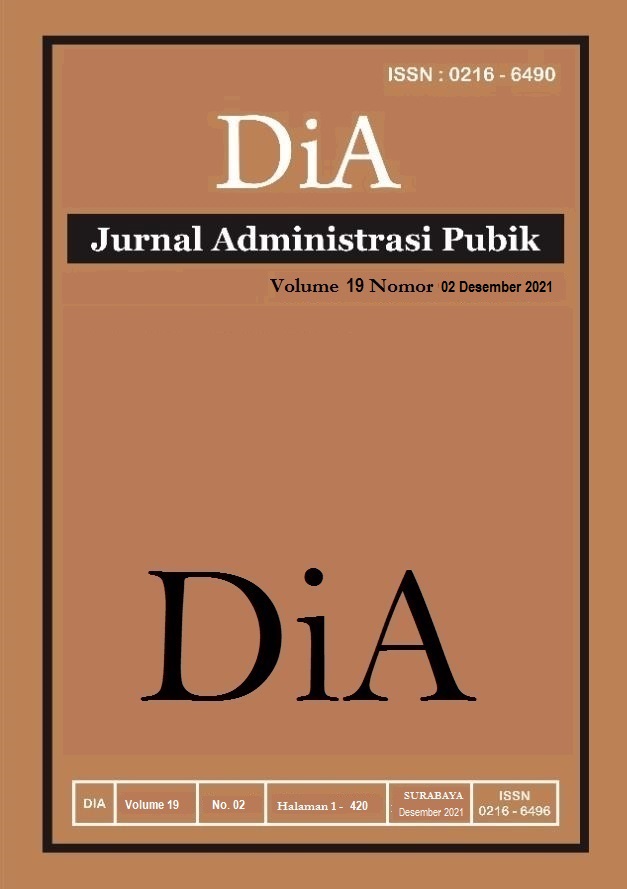TRANSFORMATION OF DEVELOPMENT TOWARDS INDEPENDENT VILLAGE IN SEKAPUK VILLAGE, UJUNGPANGKAH DISTRICT, GRESIK REGENCY
DOI:
https://doi.org/10.30996/dia.v19i2.5486Keywords:
Development Transformation, Sekapuk Village Government, and Independent VillageAbstract
The commitment of the Jokowi – Jusuf Kalla government in developing villages is stated in the third the Nawa Cita which has been mandated to “Build Indonesia from the periphery by strengthening regions and villages within the framework of a unitary state”. The purpose of this study is to describe the efforts made by the government Sekapuk Village in the transformation of development towards an independent village and to describe the inhibiting and driving factors during the process of becoming an independent village. Data collection techniques in this study used interviews, observation, and documentation, in which the data were analyzed descriptively qualitatively. The informant withdrawal technique uses a purposive technique based on criteria. All data were examined for data validity using source and data triangulation techniques and were analyzed through the process of data reduction, data presentation, and conclusion drawing. The results of this study indicate that in the efforts made, the Sekapuk Village government is in the transformation of development towards an independent village through potential mapping, coaching, and mentoring, building synergies, and implementing village governance into a modern organization. Able to realize Sekapuk Village into an Independent Village. While the inhibiting factors in the transformation of development are in the form of rejection from the community, the problem of the lack of development funds, and the location of the village which is far from urban areas. the driving factors in the transformation of development in the form of a strong will from the community, the desire to reduce the number of unemployed, and the desire to reduce the problem of slums.
Downloads
References
Adisasmita, Rahardjo. (2004). Growth Areas and Growth Areas. Graha Ilmu.
Adisasmita, Raharjo. (2006). Rural and Urban Development. Graha Ilmu.
Anggito, A., & Setiawan, J. (2018). Qualitative Research Methodology (ED Lestari (ed.); 1st ed.). CV Traces.
Basuki, & Shofwan. (2006). Strengthening Village Government Based on Good Governance. SPOD FE-UB.
Chambers, R. (1987). Village Development Starts From Behind (S. Pepep (ed.)). LP3ES.
Eliah, WE, & Yulianti, Y. (2009). Marketing Management-Designing and managing Value Networks and Channels. Postgraduate-Master's Program in Management. Trisakti University Jakarta.
Ginting, AM (2013). Development constraints of the Riau Islands province: A case study of the Riau Islands province. Politica, 4(1), 49–75. http://bakohumas.kominfo.go.id/news.php?id=1000,
Hamidi, H., & et al. (2015). Building Village Index (IDM), https://idm.kemendesa.go.id/
Hardani, Auliya, NH, Andriani, H., Fardani, RA, Ustiawaty, J., Utami, EF, Sukmana, DJ, & Istiqomah, RR (2020). Qualitative & Quantitative Research Methods (H. Abadi (ed.); 1st ed.). Science Library.
Regulation of the Minister of Villages, Development of Disadvantaged Regions and Transmigration of the Republic of Indonesia Number 2 of 2016 concerning the Index of Developing Villages, 1 (2016).
Kuncoro, M. (2004). Regional Autonomy and Development: Planning Reform, Strategy and Opportunity. Erlangga.
Kurniawan, B. (2015). Book 5 Independent Villages, Developing Villages, (Jakarta: Ministry of Villages, Development of Disadvantaged Regions, and Transmigration of the Republic of Indonesia,. Ministry of Villages, Development of Disadvantaged Regions, and Transmigration of the Republic of Indonesia.
Miles, M., & Huberman, M. (2014). Qualitative Data AnalysisSage Nain U (2019) Rural Development from a Sociohistorical Perspective (M. Faisal (ed.); Vol. 1) Equator Line
Paian Siagian S. (1983) Development AdministrationMount Agung Minister of Home Affairs Regulation No. 39 of 2015 concerning Codes and Data for Government Administration Areas, 1 (2015)
Rachmawaty, R. (2020) Standard Operating Procedures (SOP) Update on the Index of Developing Villages in 2020.Ministry of Villages, Development of Disadvantaged Regions and Transmigration.
Ranjabar, J. (2006) , Indonesian Socio-Cultural System, An Introduction, Ghalia Indonesia,
Silalahi, U. (2011), Management Principles, Refika Aditama,
Slamet, M. (1985) Increasing Community Participation in Rural Development
Soenarko (2000) Public Policy, Basic Understanding to Understand and Analyze Government Policy. Airlangga University Press.
Sugiman. (2018). Village Administration. Biblical Law, 7(1), 1–14.
Sugiyono. (2019). Quantitative, Qualitative, and R&D Research Methods (Sutopo (ed.); 1st ed.). Alphabet.
Suhaimi, U. (2011). Village Potential Data: Illustration of Utilization forIdentification Earlyof Disaster-Prone Areas. Meeting Paper on Data Base ActivitiesFacilities and Infrastructure for Disaster Prevention and Management, Directorate General of Public Administration, Ministry of Home Affairs, Jakarta.
Sumpeno. (2002). Capacity Building, Preparation and Planning. Catholic Relief Services.
Suparmini, & Wijayanti, AT (2015). Rural and Urban Communities (Geographical, Sociological, and Historical Overview). In Textbooks. Faculty of Social Sciences, Yogyakarta State University.
Supriadi, D. (2013). Analysis of Potential and Direction of Coastal Village Development in Batu Bara Regency. Postgraduate School, University of North Sumatra.
Suryanto. (2017). Acceleration Strategy to Realize Independent Villages as a Manifestation of Law no. 6 of 2014 concerning Villages. Bappenas.
Susyanti, DW (2013). Village Potential Through Rural Tourism. Economics And Business, 12(1), 33–36.
Thoha, M. (1991). Some Aspects of Bureaucratic Policy. Media Widya Mandala.
Law of the Republic of Indonesia Number 6 of 2014, 1 (2014).
Warlan Yusuf, A. (2014). Community Participation in Sustainable and Equitable City Development. Public Administration, 11(2), 53–68.
Weber, M. (2006). Protestant Ethics & the Spirit of Capitalism: The History of the Emergence and Prediction of the Development of Contemporary Industrial Culture as a whole. Student Library.
Downloads
Published
How to Cite
Issue
Section
License
The DiA journal allows authors to retain the copyright of their papers without limitation. Authors may grant publishers non-exclusive publishing rights to publish articles. Granting first publishing rights to publishers also qualifies as unlimited copyright (because there are no restrictions imposed by publishers on author copyright).






